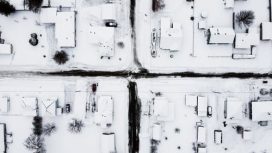Which Data Sources are the Best Indicators of Roof Risk?
 Roof condition risk will continue to put pressure on insurance carrier profitability in 2021. While existing methodologies help to mitigate some of the risk, most are not sustainable due to changing weather patterns, limited technologies and data. Certain data sources are better than others for creating reliable and predictive roof condition scores.
Roof condition risk will continue to put pressure on insurance carrier profitability in 2021. While existing methodologies help to mitigate some of the risk, most are not sustainable due to changing weather patterns, limited technologies and data. Certain data sources are better than others for creating reliable and predictive roof condition scores.
The industry has been seeking a better way of mitigating roof risks for years, but with mixed results. Compounding the issue has been the traditional means of acquiring the roof condition data, either through the insured or from an inspection. However, when you combine key data sources, with evolving analytical techniques you can create a unique and actionable roof model score to ease the risk.
While in-person inspections provide excellent information, they are very expensive and intrusive to the insurance buying experience. They also often lack the full context of the roof due to the difficulty in accessing a close view. Using data to provide greater insight into the probability of a roof claim is a viable and powerful alternative. A combination of aerial imagery analytics, weather forensics and claim clusters formed from property and auto claims data provides a highly reliable roof model score.
Evolving Data
We all know about aerial imagery’s usefulness given it is less intrusive, and how it is generally easier to validate the data. But, in most instances it still requires an underwriter to put eyes on the images to identify characteristics and issues. As the aerial imagery acquisition market becomes more competitive, providers are seeking to utilize evolving sensor technology that allows for enhanced resolution and further coverage.
Couple this with machine learning to extract data from the enhanced images, and this introduces time savings, consistency and a repeatable process. Computer vision can identify roof attributes or even property attributes. Early research has shown that when machine learning roof attributes are introduced into a roof condition score solution, the predictive nature of potential claims increases.[1]
LexisNexis® Risk Solutions conducted a claims study that assigned a Rooftop score to properties located in states impacted by weather-related claims.[2] This study analyzed the next 12 months of large weather claims involving those properties and segmented the results by score. The high-risk score group had 30 times the claim frequency of the low-risk score group in the study, and 3.5 times the claim rate of the overall population.
One other significant data input to this model is weather forensics. It is critical to see weather in a historical and real-time perspective to add greater depth to a predictive model. Thanks to technology, insurers are now able to analyze storms, hurricanes, and all National Oceanic and Atmospheric Administration recorded weather events and compare that information with how property claims arise around these storms in time and space, helping to identify frequency and severity.
The integration of aerial imagery, machine learning, and weather forensics to the traditional underwriting roof inspection is an innovative way to acquire key information to determine the roof condition.
New Insights
One of the primary underpinnings to the success of this unique Rooftop model is claim clusters based upon auto and property claims history, which delineates it from other roof condition models/inspections. Claim clusters are comprised of specific auto and property claim types within a certain time frame, distance to the property location, and definitive weather events in the area. Adding claim clusters provides ground truth to the storm location and pattern.
To reduce false positives, the claim clusters should be based upon a national claims database versus those clusters developed at only a carrier level. Additionally, the use of auto claims is unique as they are generally reported faster and the volumes add credibility in identifying the storm path. According to our national C.L.U.E.® databases, almost 60% of auto claims are filed within 10 days from the date of loss, while we saw only 18% of property claims filed in the same time frame.
Summary
Applying a solid roof strategy into your inspection framework is important in the mitigation of claim frequency and severity. The utilization of more sophisticated data sources complemented by claim clusters is required to optimally address the challenges of wind and hail.
As the COVID-19 environment dictates carriers pivot toward the use of roof inspection technology and models, the LexisNexis® Rooftop product can help carriers realize their potential exposures and how to effectively use capital to best mitigate risk to their organization. Underwriters will need to continually assess how the pandemic impacts the future of their existing programs and take advantage of more sophisticated data sources to help their organization embrace this new world.
If you would like learn how LexisNexis® Rooftop can provide a clearer view of your roof risk, download our new whitepaper.
[1] 2020 LexisNexis® Risk Solutions Industry Study of 340,000 properties in 25 U.S. states with weather claims >$5K within 12 months of the effective date.
[2] Ibid.
